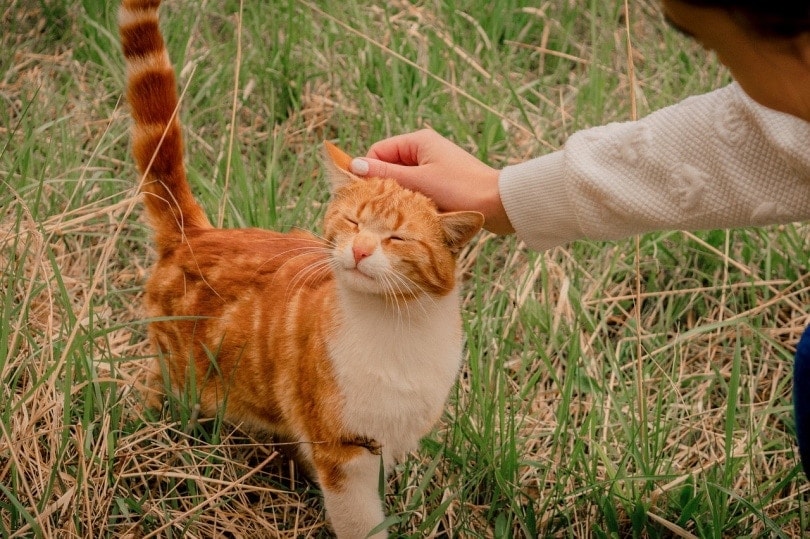Interacting with a cat is like trying to close a business deal. You do your research, pitch the offer, set expectations, and deal with any objections along the way. If all goes well, you’ve got yourself a new business partner. If not, you shrug your shoulders and hope the next one works out.
Cats take boundaries seriously, so it’s important to honor these boundaries when approaching a cat. Here’s how to do it.
The 10 Great Tips to Approach a Cat
These tips are drawn from the author’s experience on approaching a cat that’s owned by another person. Your experience may vary, and other people’s opinions may vary. The opinions do not necessarily reflect the veterinarian’s tips on approaching a cat.
Approaching a feral cat that’s frightful of humans is not recommended, and these tips might not work on such a cat. Feral cats may also carry diseases that they may potentially pass on to you or your pets and shouldn’t be approached haphazardly.
1. Get on the Cat’s Level
Some cats will run up to any stranger, but most need a little give and take on our end. You can break the ice by matching the height of the cat. That could mean:
- Crouching down on the ground
- Sitting in a chair near the cat
- Standing near a cat tree
In any case, you’ll be less intimidating and more inviting. Getting on the cat’s level will show the cat you’re willing to submit.

2. Provide Personal Space
Cats need personal space with strangers. Otherwise, they will feel cornered and become aggressive. In addition, personal space allows cats to run if they need to hide. Space gives them peace of mind without feeling cornered.
3. Move Slowly
Fast movement is a quick way to scare a cat. Why? Because the situation can get out of control with rapid movement, at least from the cat’s perspective. Walking bit by bit, sitting slowly, and gently offering your hand gives the cat time to think about their next move.

4. Use a Soft Voice
A soft-spoken voice is likely more calming for a kitty, so your tone may help a cat feel at ease when they first meet you. Cats eventually learn your voice and may even approach you when they hear you in the room.
5. Don’t Stare Intensely
Would you approach a stranger staring deep into your soul? Probably not. Cats are creeped out about it, too. Instead of staring intensely into the cat’s eyes, slowly blink as if you’re saying, “I love you.” The cat will know what you mean!

6. Let the Cat Sniff Your Hand
Present your hand to the cat slowly, as if your hand were an animal’s nose. Allow the cat to sniff your hand for however long they want. Some people have had better success when their palms face down instead of facing up. Either way is acceptable, as long as you don’t pet the cat.
If the cat seems skittish, it’s best to face your palm downward and make a fist. This is to minimize the risk of injury in case the cat decides to bite your hand; a fist is less likely to be caught in a bite when compared to a finger.
7. Petting Is Invitation-Only
Petting a cat is like getting into an exclusive club: it’s an invitation-only event. Still, many people mistakenly pet a cat too soon after letting the cat sniff their hands. This may offend or spook the cat, ruining the interaction. You must follow cat interaction rules to make a good first impression.
Anecdotally, these might be good precautions with early interactions with a new cat.
- Let the cat sniff your hand and wait for a head butt.
- You’re free to scratch the head if the cat willingly rubs her face against your hand.
- If you don’t receive a head butt, the deal is off. No touching!
- Never pick the cat up.
- Never touch the forbidden belly.

8. Watch the Cat’s Body Language
For some people, cats are somewhat difficult to read because their facial expressions aren’t as obvious as those of dogs. Cats communicate through body language, like the tail and full body movements.
You’ll have a better relationship with cats overall if you can identify the difference between negative and positive cat reactions.
9. Listen to the Owner
It seems like common sense, but it’s worth repeating: listen to the owner. The owner knows the cat better than you, so take any advice when getting to know a new furry face.

10. Reintroduce Yourself
Rome wasn’t built in a day, and neither is a beautiful relationship with an animal. It’s true that some cats are social butterflies and will love everyone. Even so, it’s safe to assume that most cats won’t be your best friend immediately.
Reintroduce yourself by following all of the tips we just mentioned. You’ll be best friends in no time. Or at least good acquaintances!

Conclusion
There’s an art to befriending a cat, so don’t take it personally if a cat doesn’t like you right away. Even friendly felines like some space when getting to know their new best friends. The best thing you can do is honor the boundaries set before you. Wouldn’t you want the same when meeting someone new?
Featured Image Credit: PHOTOCREO Michal Bednarek, Shutterstock










